There is an exponential growth in mobile data in recent times due to large number of registered users and their demand for high quality multimedia content. To cater for this ever-growing data requirement, mobile communication networks are being evolved into fifth generation of systems (5G) which is expected to provide 5-50 Gbps of data rates. Currently 2G, 3G, 4G and Long Term Evolution-Advance (LTE-A) are operating between 700 MHz-3.6 GHz radio spectrum. This spectrum has increasingly being congested, therefore there is a need for spectrum upgradation. For this to happen several feasibility studies and experiments have already been carried out to explore RF spectrum above 3.6 GHz, especially above 6 GHz for mobile communications.
The 5G mobile network of the future is a big leap when compared to traditional mobile communication networking of recent times. It will have an unprecedented ultra-fast broadband connectivity speeds of 20 Gbps (downlink) and 10 Gbps (uplink) during peak data throughputs. The latency of 5G will be less than 5 milliseconds, which open doors for a wide range of applications that could be integrated into this network. Future 5G will the most reliable data communication network that can be used for various applications. These applications are not limited to voice and data only, but will consist of machine-to-machine (M2M), vehicle-to-vehicle (V2V) and even machine-to-human (M2H) communications. In a nutshell, the future 5G network of communication is about connecting everyone and everything among themselves. It will transform the world we live in today into a totally machine centric world providing ubiquitous connectivity for all.

To visualize 5G consider a few use cases that are only possible with ultra-wide bandwidth, very high connectivity speeds, and extremely low latencies. Recently the trend in complex computing is to shift towards online cloud servers. The most important and intensive computing of modern times is the 3D rendered motion pictures found in computer gaming. High speed real-time rendering may also be found in landscape modeling via flying drones with LiDars. These require a large amount of data to be transferred with high speed with virtually zero latency. Another use case to mention is that of augmented reality. In augmented reality, real-time pictures and videos are combined with useful and informational computer data. For example, while in on a city trip in another country with a different culture and language, one might want to translate banners found on the road. This can be done while connected to a high speed mobile network that can provide information in real-time in response to and combined with a real-time video being recorded. Finally consider a long caravan of transport vehicles on a very long journey. The requirement of multiple drivers can be eliminated if these vehicles are link together through a very low latency and highly reliable communication network. The vehicles can be guided from start to destination completely without human interaction from a remote server room. There are an infinite possible use cases for the capabilities provided by 5G communication network but the cases discussed here give a good idea of what the future has installed for the human society.
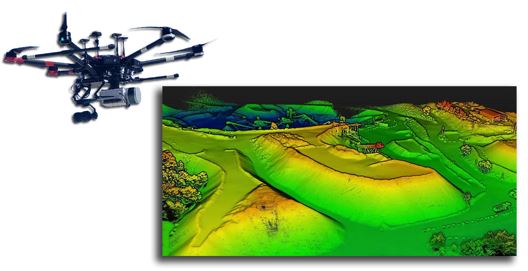
The essence of 5G communication is its wireless connectivity, which is only possible through an antenna system. For a very large bandwidth that 5G promises, the key solution is the availability of an empty spectrum. This is, as mentioned earlier, only present at very high frequencies above 20 GHz called the millimeter-wave range. The International Telecommunication Union (ITU) has recommended an exhaustive list of frequency bands for 5G applications, however, for mobile communication in most of the countries 28, 38, 42 and 60 GHz bands are the most prominent ones. To operate at these frequency ranges, an antenna system that is capable of delivering very large bandwidth in millimeter-wave spectrum is an absolute requirement. However, electromagnetic propagation in millimeter-wave spectrum has challenges of its own. The most important of which is its propagation loss over long distances. At very small wavelengths, the free space attenuation is of multiple orders which greatly degrades communication for long distances. On top of free space attenuation comes losses due air water droplets and oxygen levels. To further complicate the matter, there are very high penetration losses involved in propagation through building walls and glasses. These challenges are extremely crucial when it comes to attaining reliable connectivity promised by 5G, and must be solved at an antenna sub-system level.
The multitude of millimeter-wave propagation challenges can be solved by an antenna system by employing intelligent design methodologies. These methodologies are engineered in such a way that they enhance an antenna’s radiation characteristics. These characteristics primary consists of impedance bandwidth, directivity, gain and beam formation. Millimeter-wave attenuation for example can be mitigated via high directivity and gain, while path losses in dense urban environment can be avoided by deploying multi-beam formation. Large bandwidth is subject to antenna’s geometric layout which requires careful conceptualization as well visualization efforts.
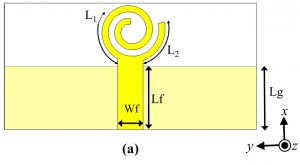
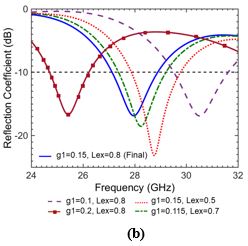
In order to attain these daunting antenna capabilities in relation to 5G requirements, we have researched into designing various millimeter-wave antennas. The antennas designed, fabricated and tested at Research Institute for Microwave and Millimeter-wave Studies (RIMMS) – NUST have been verified to provide very good results for use in 5G mobile devices especially handheld phone devices. The typical gain requirement for a mobile handset in 5G is around 5-10 dBi. The directivity requirements have been found to be in the range of 12o to 30o HPBW. The antenna impedance bandwidth for 5G allocated bands ranges from 1-4 GHz around the center frequency. We have, therefore, modelled state-of-the-art 5G planar compact antennas that achieve most of these critical ranges mentioned above.
Considering large bandwidth requirement, for example, a novel spiral antenna array system has been designed and modelled in CST CAD tool in the time domain. A portion of this antenna system is shown in Fig. 3(a), where both layers of its single element is visible. To appreciate its impedance response, some of its bandwidth profiles are depicted in the adjacent Fig. 3(b). In our work, we have obtained more than 10 GHz of bandwidth with different antenna geometries. Similarly, we have obtained high gain values by realizing various array configurations for these antennas. Proprietary corporate feed networks were modelled mathematically as well as programmatically to provide feeding signals to our single elements antennas. A cut-out image depicting a junction point of an array element and the network is shown in Fig. 4 (a). Gain ranges around 10 dBi and above have obtained as shown in Fig. 4(b).
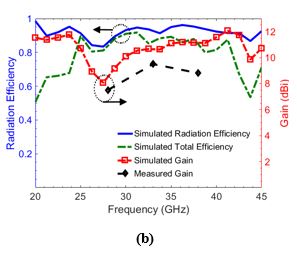
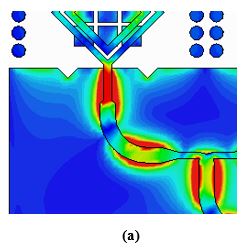
Furthermore, intriguing geometries were developed in order to meet some of 5G application specific requirements. One of these specifications is that of a multi-beam radiation pattern formation. A snowflake antenna geometry of Fig. 5(a), for example, has been realized that gives a perfect 90 degrees of separation between two narrow power beams. It must be stressed here that probably the most important 5G antenna specification that we have catered so for in our lab experiments is the control of HPBW of the main power beam. We have obtained an astounding 10 degrees of narrow HPBW in a single plane. One of the results is shown in Fig. 5(b), where two power beams directed in 0o and 180o should be observed. A less than -10 dB of SLL can clearly be seen, which is a much appreciated feature of most of the antenna arrays that we have developed.
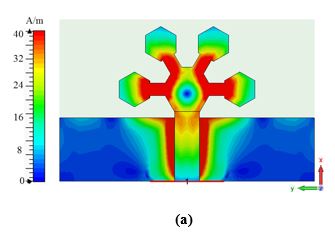
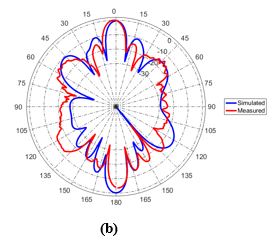
The above mentioned snippets from our research endeavors is just the tip of an ice-berg, presented here to motivate those who want to join. We have developed antennas have configuration in the form of single elements as well in arrays. Novel geometric solutions that not only include spiral and snowflake, but also honeycomb, Vivaldi, SIW, Rotman, hexagon, Rhombus, Tri-cell and meandered designs. The measurements were carried out at in-house facilities which include up to 40 GHz anechoic chamber, 43 GHz vector network analyzer (VNA) and high precision PCB manufacturing machines. The millimeter-wave antennas tested at RIMMS have been found to provide robust performances with very large bandwidths (2-10 GHz), large gains (4-12 dBi) and very narrow HPBW (14o in one plane).
References
-
Hidayat Ullah, Farooq A. Tahir, “A Broadband Wire Hexagon Antenna Array for Future 5G Communications in 28 GHz Band”, Microwave and Optical Technology Letters, Vol. 61, no. 3, pp. 696-701, March 2019. (https://doi.org/10.1002/mop.31613)
-
Hidayat Ullah and Farooq A. Tahir, “Broadband planar antenna array for future 5G communication standards”, IET Microwaves, Antennas & Propagation, Vol. 13, no. 15, pp. 2661-2668, 2019. (http://dx.doi.org/10.1049/iet-map.2018.5603)
-
H. Ullah and F. A. Tahir, “A Novel Snowflake Fractal Antenna for Dual-Beam Applications in 28 GHz Band,” in IEEE Access, vol. 8, pp. 19873-19879, 2020. (doi: 10.1109/ACCESS.2020.2968619)
-
H. Ullah and F. A. Tahir, “A High Gain and Wideband Narrow-Beam Antenna for 5G Millimeter-Wave Applications,” in IEEE Access, vol. 8, pp. 29430-29434, 2020. (doi: 10.1109/ACCESS.2020.2970753)
-
Hidayat Ullah, Farooq A. Tahir, “A wide‐band rhombus monopole antenna array for millimeter wave applications”, Microwave and Optical Technology Letters, Vol. 62 , no. 5, pp. 2111-2117, May 2020. (https://doi.org/10.1002/mop.32289)
The author is an Associate Professor and HoD (Research) at Research Institute for Microwave and Millimeter-wave Studies (RIMMS) NUST and can be reached at farooq.tahir@rimms.nust.edu.pk





